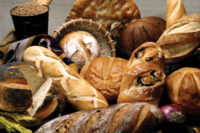September is Whole Grains Month, and the Boston-based non-profit Oldways Whole Grains Council (WGC) is encouraging people everywhere to join the celebration by supporting “Good Grains for a Good Cause.”
Whole grain lovers can participate by nominating their favorite charities that address food insecurity—a food pantry, soup kitchen, or other organization. At the end of September, one qualifying charity will be randomly selected to win a wealth of delicious whole grain foods and national recognition. Nominations will be accepted on the Whole Grains Council website through September 30, 2017.
The following companies have donated prizes for the contest: Back to Nature, Barbara’s Bakery, Bob’s Red Mill, Catallia Mexican Foods, Dr. Kracker, Freekehlicious, Grainful, Hodgson Mill, InHarvest, Kellogg’s, Lotus Foods, Lundberg Family Farms, Mary’s Gone Crackers, Ozery Bakery, Palouse Brand, and Popsalot.
We were recently able to speak with Kelly Toups, MLA, RD, LDN, who is the director of nutrition at Oldways.
Liz Parker: Can you talk a bit about whole grain trends in snack foods, including gluten-free grains, if applicable?
Kelly Toups: The International Food Information Council’s 2017 Food and Health Survey found that an overwhelming 84 percent of consumers consider whole grains to be healthful, following only vitamin D (88 percent) and fiber (87 percent). Additionally, more than 65 percent of consumers report that they are eating more foods with whole grains compared to years past. To help meet this need, the Consumer Goods Forum Health and Wellness Report notes that more than 180,000 products have been reformulated in 2016, and that increasing whole grains is a key target for 25% of respondents.
When it comes to the types of whole grains in snack foods, ancient grains continue to make a splash. Of the products registered for Whole Grain Stamp use in the US over the past six years, there are five clear frontrunners when it comes to growing popularity, all of which are naturally gluten-free. The most notable is quinoa, which is now included in almost 10 percent of all Stamped products sold in the US (compared to only 3 percent) in 2011. Sorghum has also made impressive gains with its prevalence increasing fourfold in six years. Millet, amaranth, and teff follow. These grains were virtually unknown to most shoppers 5 to 10 years ago, but now they are incorporated into mainstream products such as granola bars, breads, hot cereals, and more.
These trends are in line with what we are seeing elsewhere in the food industry. According to the National Restaurant Association’s 2017 Culinary Forecast, ancient grains are a top (#14) food trend, along with protein rich grains/seeds (#17). Non-wheat noodles (#33), farro (#50) black/forbidden rice (#53), and quinoa (#81) also made the list.
LP: Are there any new health studies out regarding whole grains?
KT: Research repeatedly demonstrates the benefits of making the switch to whole grains. In a study about diet and aging published last month in PLOS One, whole grains were singled out for their link with cognitive benefits. In another study published this year, Boston researchers found that whole grains may help your body burn more calories. There have been more than 100 studies about the health benefits of whole grains published in the past five years alone, many of which are listed in our health studies database. We are currently working with a post-doctoral researcher to release a comprehensive review of these studies, and we plant to make the PDF available on our website by the end of September. This handout is a great overview of some of the major health benefits of whole grains, which we created when a food manufacturer requested help in communicating to their customers the health advantages of whole grain products.
LP: How did you get the idea for Good Grains for a Good Cause, and when was the initiative started?
KT: The Oldways Whole Grains Council first introduced Good Grains for a Good Cause back in 2013 for Whole Grains Month. We invited people across the country to nominate their favorite food-related charity to receive cases and cases of whole grain foods donated by food manufacturers, and spotlighted charitable efforts of Whole Grains Council member companies.
We had such a good response in 2013 (nearly 500 nominations came in from 39 states for food pantries, soup kitchens and other organizations) that we decided to return to this campaign again this year. We hope we can top that amount of nominations and encourage everyone to nominate their favorite charity by going to: https://wholegrainscouncil.org/good-grains-good-cause-2017
An estimated 42 million Americans experience food insecurity—uncertain access to adequate food. Yet many of those in need are also grappling with obesity and chronic disease. Charities throughout the country are doing important work to provide healthy foods to Americans needing support, and during Whole Grains Month, we want to honor these efforts.
LP: What are the origins of Whole Grains Month?
KT: The Oldways Whole Grains Council started Whole Grains Month in 2011 to shine a spotlight on the health benefits and great taste of whole grains. Although the new year technically begins in January, September is the time when many of us think about starting new routines and habits. Summer, with its “everything goes” vacation mentality, is fading away, and we’re all heading back to school or work with new energy. Whole Grains Month is September is the perfect time to try some new whole grain recipes or foods.
A lot has changed since the first Whole Grains Month celebration six years ago. Back in 2011, the Whole Grain Stamp was on about 6,000 products. Today, that number has nearly doubled to 11,000. Best of all, 2 out of 3 people now make at least half their grains whole, according to our 2015 Whole Grains Consumer Insights Survey.
Kelly Toups, MLA, RD, LDN is director of nutrition at Oldways, and serves as director of the Oldways Whole Grains Council. Oldways is a nonprofit organization dedicated to improving public health via traditional eating choices. Oldways offers educational programs and recipes based on cultural heritage, the goodness of whole grains, and the practices of traditional cheese-making. Find out more at www.oldwayspt.org.








.png?height=200&t=1643248453&width=200)
